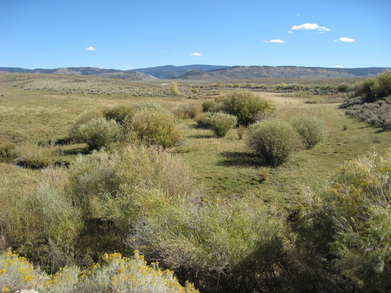Ecological Assessment Projects
Gros Ventre River Campground Environmental Assessment/Affects Analysis - Teton County, Wyoming
Biota was contracted by GTNP to edit and expedite a draft EA for public comment. The document was edited on the basis of overall content, consistency, and formatting. Internal review comments from GTNP and NPS Intermountain Region staff were incorporated into a revised draft Gros Ventre Campground EA. The document analyzed two alternatives: a no-action alternative and an alternative to improve critical infrastructure, including new water and wastewater systems. The two alternatives were evaluated for impacts to archaeological and ethnographic resources, soils, vegetation, water resources (surface, groundwater, and floodplains), wildlife, park operations, and visitor use and experience.
Biota was contracted by GTNP to edit and expedite a draft EA for public comment. The document was edited on the basis of overall content, consistency, and formatting. Internal review comments from GTNP and NPS Intermountain Region staff were incorporated into a revised draft Gros Ventre Campground EA. The document analyzed two alternatives: a no-action alternative and an alternative to improve critical infrastructure, including new water and wastewater systems. The two alternatives were evaluated for impacts to archaeological and ethnographic resources, soils, vegetation, water resources (surface, groundwater, and floodplains), wildlife, park operations, and visitor use and experience.
Grand Teton National Park Fire Management Plan Environmental Assessment
Biota was contracted by GRTE to complete all sections of a programmatic EA associated with the park’s Fire Management Plan. Biota conducted consultation and coordination associated with this project, including working directly with park planning, fire, and natural resource management personnel. The plan was well received by the public and the Park Superintendent, who subsequently wrote:
Biota exceeded expectations in regards to helping the park understand how to relate fire management activities to the public, identify measurable goals and objectives, and assimilate voluminous information and professional comments in compiling a document that surpassed standards. Not only did the park service and local community respond with satisfaction, but many of our environmental conservation organizations complimented the park on a well-written and scientifically superior document… Moreover the Intermountain Regional office acknowledged that the EA is an outstanding document and has referred it to other parks as a good example….Biota’s knowledge, skill, and ability facilitated the challenge to create a legally-defensible NEPA document in accordance with NPS policy.
---Mary Gibson Scott, Superintendent, Grand Teton National Park
Biota was contracted by GRTE to complete all sections of a programmatic EA associated with the park’s Fire Management Plan. Biota conducted consultation and coordination associated with this project, including working directly with park planning, fire, and natural resource management personnel. The plan was well received by the public and the Park Superintendent, who subsequently wrote:
Biota exceeded expectations in regards to helping the park understand how to relate fire management activities to the public, identify measurable goals and objectives, and assimilate voluminous information and professional comments in compiling a document that surpassed standards. Not only did the park service and local community respond with satisfaction, but many of our environmental conservation organizations complimented the park on a well-written and scientifically superior document… Moreover the Intermountain Regional office acknowledged that the EA is an outstanding document and has referred it to other parks as a good example….Biota’s knowledge, skill, and ability facilitated the challenge to create a legally-defensible NEPA document in accordance with NPS policy.
---Mary Gibson Scott, Superintendent, Grand Teton National Park
Environmental Analysis — Teton County, Wyoming
An environmental analysis was performed on a 240-acre parcel in Jackson Hole. This study involved collecting baseline information wildlife “species of special concern” and their habitats, and other protected natural. Recommendations were made that, to the maximum extent practicable, would reduce potential impacts to these resources while still allowing future development to be constructed on the property.
Ecological Baseline Inventory — Sublette County, Wyoming
Biota conducted an ecological baseline inventory on a 245-acre parcel of the Seven Mile River Ranch near Pinedale, Wyoming. This study provided baseline data necessary for a conservation easement to be established on the parcel. The study report described the biotic and abiotic characteristics of the property and its surroundings, wildlife use, vegetative communities, and historic and current uses of the property using aerial maps, detailed figures, and text.
An environmental analysis was performed on a 240-acre parcel in Jackson Hole. This study involved collecting baseline information wildlife “species of special concern” and their habitats, and other protected natural. Recommendations were made that, to the maximum extent practicable, would reduce potential impacts to these resources while still allowing future development to be constructed on the property.
Ecological Baseline Inventory — Sublette County, Wyoming
Biota conducted an ecological baseline inventory on a 245-acre parcel of the Seven Mile River Ranch near Pinedale, Wyoming. This study provided baseline data necessary for a conservation easement to be established on the parcel. The study report described the biotic and abiotic characteristics of the property and its surroundings, wildlife use, vegetative communities, and historic and current uses of the property using aerial maps, detailed figures, and text.

Natural Resource Inventory — Gallatin County, Montana
Biota’s biologists and wetland scientists completed a comprehensive natural resource inventory of a 1,700-acre ranch near Yellowstone National Park. As part of this study, important environmental resources were inventoried, wildlife use was documented, agency experts and persons familiar with the property were interviewed, past and present land uses were examined, and future development and management recommendations were made. The final report documented all existing natural resources on the property including vegetative cover types, hydrologic features, and ecological characteristics.
Environmental Feasibility Study — Fremont County, Wyoming
This study assessed the environmental feasibility of an irrigation project on 3,814 acres of the Wind River Indian Reservation in west-central Wyoming. The likely impacts of this development on vegetative communities, riparian and wetland areas, rare plants, fish and wildlife resources, and threatened and endangered species were investigated and documented. All necessary environmental permits to move forward with the proposal were disclosed and recommendations were made to reduce the impact to the ecological resources of the project area through environmental constraints and mitigation efforts.
Grand Teton National Park Transportation Plan -- Environmental Impact Statement
Biota completed the wildlife, vegetation, and wetland sections (existing conditions and environmental consequences) for the Draft EIS. Biota also provided a technical review of all sections of the Draft EIS for content, methodology, and compliance and will be involved in completion of the Final EIS. This project required extensive coordination with 3 other consulting firms as well as National Park Service staff (in Grand Teton and the Denver Service Center).
Biota completed the wildlife, vegetation, and wetland sections (existing conditions and environmental consequences) for the Draft EIS. Biota also provided a technical review of all sections of the Draft EIS for content, methodology, and compliance and will be involved in completion of the Final EIS. This project required extensive coordination with 3 other consulting firms as well as National Park Service staff (in Grand Teton and the Denver Service Center).
Natural Resource Inventory — Beaverhead County, Montana
Biota conducted a detailed natural resource inventory of a 1,700-acre ranch along the Big Hole River near Divide, Montana. All important and sensitive environmental resources were inventoried, wildlife distribution and use patterns were documented, past and present land uses were assessed, and recommendations were made regarding future development and land use plans for the property. A variety of small ponds and larger wetland development areas were designed in an effort to improve wildlife habitat on the ranch.
Biota conducted a detailed natural resource inventory of a 1,700-acre ranch along the Big Hole River near Divide, Montana. All important and sensitive environmental resources were inventoried, wildlife distribution and use patterns were documented, past and present land uses were assessed, and recommendations were made regarding future development and land use plans for the property. A variety of small ponds and larger wetland development areas were designed in an effort to improve wildlife habitat on the ranch.
